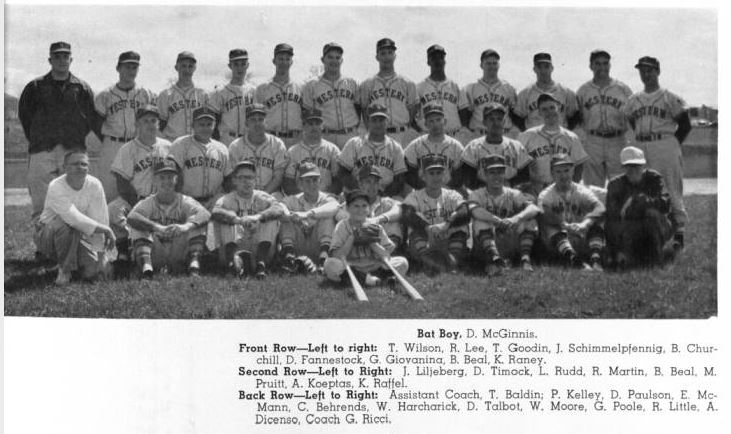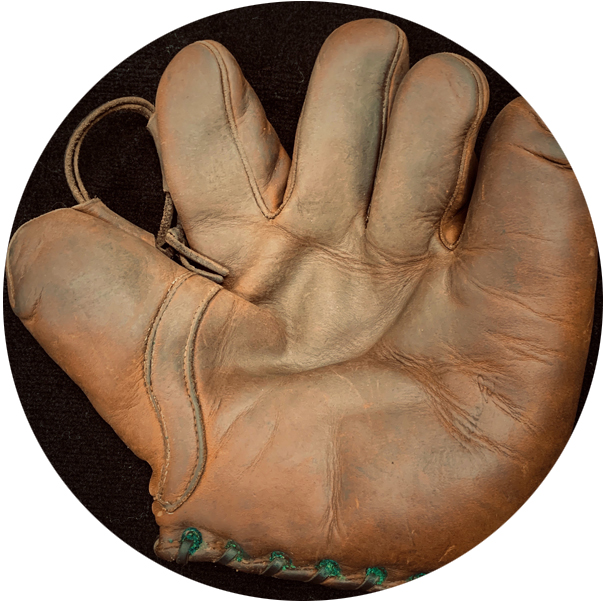By Logan Elko
Fall weather is quickly approaching, and with it, the World Series. Baseball has been an American staple since its inception. The game has been played in some form or another since before the Civil War, but like any game, it has evolved over the years. Baseball has had a massive cultural impact across the United States and even the world.

Recent acquisitions to the museum’s collection include baseball equipment dating from the 1930s to 1950s. On display at the Western Illinois Museum this month are three baseball gloves. Two of the gloves are from the thirties and the difference in the style between these gloves and Major Leaguers now use is astounding. These two gloves are from the Macomb area but have ties in style to the gloves that the legendary baseball players Yogi Berra, Babe Ruth, and Joe DiMaggio fielded during their careers.
One of the gloves currently on display is a Rawlings Playmaker Model glove. It was manufactured during the fifties by the Rawlings company in St. Louis, Missouri. It is a right-handed glove. What is unique about this piece is that there are only four fingers, which counters the five-fingered designs of the previous decades and even today. This shows that the game was never static, but that innovations were always sought, even if they failed to become popular.
The three baseball gloves are from the Table Grove and Industry area and were donated by Mr. William E. Kost, a longtime resident of the Vermont area. The two gloves from the thirties were used by his father during his high school career in Table Grove, and the Rawlings glove was used throughout William E. Kost’s grade school and high school career in Industry.
The thirties were a trying time for America; the Great Depression and the aggressive expansions of Nazi Germany and Imperial Japan put strains on the United States to maintain its status quo. However, despite the crashing economy and the emerging challenge to world order, the average American at this time would have looked to the radio for entertainment.

Besides the radio drama type programs and music that was quite common on the radio in the United States at the time, sports broadcasts were just as important. During the thirties it was the “Golden Age of Baseball,” but the lack of jobs and income during the Great Depression prevented the average American from traveling to attend the professional baseball games in the big cities. Thus, the radio, also enjoying its golden age, became one of the most important mediums for following professional sports. But this was not always the case. As radio first became prominent in American society the owners of the teams resisted allowing the games to be broadcast for fear of losing revenue. However, because of the lack of income during the Great Depression, the team’s owners had to adapt, and so, the owners moved games onto the radio. They soon found that advertising was another source of revenue. This also provided Americans with the option to listen to the games for free, without spending their already sparse finances on tickets. Soon, listening to the game on the radio was a popular family activity and built loyal fans for teams.
Children growing up in this era of baseball could turn to heroes like Babe Ruth, Dizzy Dean, Lou Gehrig, and others for inspiration. This child could have listened to the radio, fallen in love with baseball, and then decided to agitate his parents for a glove or save up for one himself. A glove such as the one in our collection would provide the child with something real from the game, not just some audio being played through a machine. However, procuring this glove would be of no easy feat. Comparatively speaking, the $10.00 glove in 1930 would, when adjusted for inflation, cost $150 today.
The Rawlings glove is from the 1950s. The United States had just overcome Nazism and fascism, and the economy had begun to expand. Over the years since the depression baseball saw challenges such as low attendance, lack of excitement, a ‘monopoly’ of talent, and relocation of teams. Low attendance continued to plague the game into the fifties, despite the increased purchasing power of the average American. A lack of excitement created a dilemma with the owners of the teams, as the three teams from New York- The Dodgers, the Giants, and the Yankees- created a virtual monopoly on success during this decade. Because of this, teams that struggled to find success would be forced to relocate to other cities, much like the relocation of the Washington Senators to Minneapolis, where they became the Twins.

Attendance, however, at professional games would not have mattered much to the average child during this era. What mattered was the success of his team and the success of his heroes. However, when these baseball teams left, such as the St. Louis Browns’ move to Baltimore in 1953, a child lost his ability to identify with his local team.
Baseball in west-central Illinois could not have hoped to produce frequent attendees to professional games, as the nearest professional team was in St. Louis, Missouri. The fans then were more regional and factional than today, as there was limited access to view or listen to teams from across the country. In modern society, it is much easier to keep up with every team in Major League Baseball thanks to dedicated channels and the internet, than it was during the thirties or even the fifties. Therefore, Western Illinois University (WIU) provided the closest option to a professional team in this area.

According to the WIU baseball team’s record book, Western’s team has been keeping records since the 1948 season. Coaching records are not as reliable until the 1955 season, however, but it is during this era when WIU produced its winningest coach, Guy Ricci. The Leathernecks would have been playing during this era with equipment like that of the Rawlings glove on display this month. The local university would have provided the region with a quality baseball team to watch and root for.
The baseball gloves are currently on display throughout the month of October at the Western Illinois Museum, 201 South Lafayette Street. The museum is open Tuesday through Friday 9:00 am to 4:30 pm and Saturdays from 9:00 am to1:00 pm. Admission to the museum is free, but donations are appreciated.
